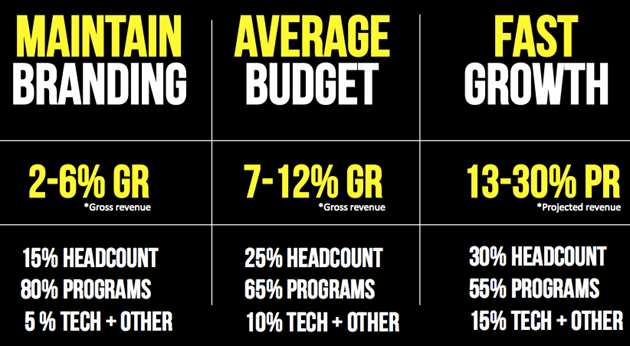
Budgets aren’t sexy, but they are one of the major prerequisites of high-performing marketing organizations.
And the trick to developing a best-in-class marketing budget is, first, to form a new conceptualization of what marketing is; then, to know the correct budget type for your growth stage; and, finally, to understand the power of stretch budgets.
If you can master those three keys, you’ll create a best-in-class marketing budget—and be well on your way to marketing success.
1. The best marketing budgets start with new ideas about what Marketing is
It’s no surprise that high-performing marketers average 14 marketing tools, double that of underperformers, according to the State of Marketing 2017 report by Salesforce. Moreover, high-performing marketing organizations plan to increase their spending on tools and technology in the coming year, the report also found.
So, those high-performers have not only larger budgets already but also plans to grow those budgets significantly still.
Best-in-class marketing budgets don’t just happen; the highest levels of the business support them. We have all tried to ask for more money—only to be told “no.” High-performers don’t have that issue, because their executives have a better understanding of what it takes to be a high-performing marketing organizing.
In short, they understand marketing and best-in-class marketing budgets aren’t what they used to be.
And without the adoption of current ideas about marketing—without a new conceptualization of marketing—your organization will be stuck with an old budget from a different marketing era.
Accordingly, executives must first by into these four tenets of modern marketing:
- Marketing is no longer a siloed department.
- The new consumer is not like the old.
- Marketing has an enormously larger role and scope.
- Technology is the only way to scale modern marketing efforts.
If your executive team can give you full support on those four ideas, and not just that they need more marketing, then you have change at getting a best-in-class marketing budget. If they cannot, they will expect you to be a magician, not a marketer.
Make sure you know the difference between those differing expectations, so you know when it’s time to leave!
2. The best marketing budgets match your growth stage
Once the executive team has bought into the new understanding of marketing, it’s time to begin setting your actual budget.
The biggest factor determining your best-in-class budget is your business’s growth stage: Companies that are stable and looking only to maintain their position in a market should have a budget that’s very different from the budgets of those that are looking for very fast growth.
If all you need to do is maintain branding, a budget of 2% (based on gross revenue) is a decent budget at the low end of the spectrum; at the high end, you may see up to 6% for very progressive companies in the same stage of growth.
Traditionally, Marketing’s average budget was just 2% of gross revenue; now, however, the average-growth budget is between 7% and 12% of gross revenue.
Note that both those budget stages—maintenance and average growth—are budgets based on gross revenue. That approach changes, however, when we move on to marketing budgets for the fast-growth stage.
If you are looking to grow quickly, and you have targets of over 50% growth per year, you need to consider yourself in the fast-growth stage. Companies in this stage need to realize that best-in-class marketing budgets are based on projected revenue, not current gross revenue, and those budgets range from 13% to 30% of projected revenue.
The following chart gives a summary of how marketing budgets are set in those three stages of growth—with a breakdown across headcount, programs, and technology.

A good example of a company in fast-growth mode—in the very fast-paced marketplace of marketing technology—is Uberflip, provider of software that helps marketers create, manage, and optimize content experiences in the various stages of the buyer journey. In a conversation, Uberflip’s (now former) VP of marketing, Hana Abaza (now head of marketing at Shopify), noted that she prefers to look at “percentage of revenue target” for setting the company’s budget rather than percentage of gross revenue.
Doing so allows her to keep her budget in line with what the projections are, rather than what the current revenue is, she said. Abaza also pointed out that Uberflip broke down its budget in the following way: 32% going to headcount, 53% to programs, and 15% to other (tech, swag, etc.).
3. The best marketing budgets are flexible
Having a set budget is great, sure, but Marketing is in a constant state of flux. Tools, channels, and trends change every day, and it’s hard to keep up if your budget is too rigid. The final key to best-in-class marketing budgets, therefore, is their ability to change with their environment.
Tim Kopp, a marketing technology adviser and former CMO of ExactTarget, commented in an interview that he “wanted a marketing budget which (he) could snap apps into.” He knew that circumstances change at high rates of speed, and he understood that a good marketer is only as good as the marketing budget will allow at any given moment.
His flexible budget helped lead to ExactTarget’s explosive growth into an industry leader before it was acquired by Salesforce in 2013 for $2.5 billion.
The trick to creating a flexible budget is to have the necessary conversations up front. Consider the flex budget as a line of credit: It’s preapproved, it’s set up, and its terms and conditions are applied when/if it’s used.
Similarly, you would go to your bosses and set up the parameters of the flex budget, including when it can be accessed.
A good approach is to start with a predefined number, say 50%, so that if you ever run a campaign that performs 50% better than its goal, you are instantly allowed to access the flex budget to double-down on the campaign or idea. Doing so allows you to maximize the impact of great ideas by having the money instantly accessible.
The trick, again, is to set it all up at the beginning so it is available when you need it.
* * *
If you can follow these three keys to setting up best-in-class marketing budgets, you are well on your way to becoming a high-performing marketing organization.
Good luck, and let me know if you ever struggle with these conversations with your boss. We’ve all been there, and I’m always happy to listen to you vent!
